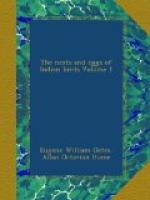“In the Andamans,” writes Davison, “they breed in April and May, building a nest of grass, dried leaves, &c. in holes of trees.” He also, however, never took the eggs.
Mr. J.R. Cripps tells us that this species is “common during March to October in Dibrugarh, after which it retires to the hills which border the east and south of the district. About the tea-gardens of Dibrugarh there are always a number of dead trees standing, and in these the Grackles nest, choosing those that are rotten, in which they excavate a hole. I have seen numbers of nests, but as these were so high up and the tree so long dead and rotten, no native would risk going up.”
Mr. J. Inglis notes from Cachar:—“This Hill-Mynah is common in the hilly district. It breeds in the holes of trees during April, May, and June.”
Major C.T. Bingham writes from Tenasserim:—“I saw several nest-holes of this bird, which was very common in the Reserve, but none of them were accessible; and it wasn’t till the 18th April that I chanced on one in a low tree, the nest being in the hollow of a stump of a broken branch. It was composed and loosely put together of grass, leaves, and twigs, and contained three half-fledged young and one addled egg of a light blue colour, spotted, chiefly at the large end with purplish brown.”
The eggs very similar to those of E. religiosa, but, what is very surprising, it is very considerably smaller.
Of E. religiosa the eggs vary from 1.2 to 1.37 in length, and from 0.86 to 0.9 in breadth, and the average of eight is 1.31 by 0.88.
This present egg only measures 1.12 by 0.8, and it must, I should fancy, be abnormally small.
In shape it is an extremely regular oval. The ground is a pale greenish blue, and it is spotted and blotched pretty thickly at the large end (where all the larger markings are) and very thinly at the smaller end with purple and two shades (a darker and lighter one) of chocolate-brown, the latter colour much predominating. The shell is very fine and close, but has but little gloss.
And later on Major Bingham again wrote:—“One of the commonest and most widely spread birds in the province. The following is an account of its nidification:—
“This bird lays two distinct sizes of eggs, all, however, of the same type and coloration. Out of holes in neighbouring trees, on the bank of the Meplay, on the 13th March, 1880, I took two nests, one containing three, and the other two eggs. The first lot of eggs measured respectively 1.15 x 0.77, 1.15 x 0.80, and 1.16 x 0.79 inch; while those in the second nest 1.30 x 0.95, and 1.27 x 0.93 inch respectively. All the eggs, however, are a pale blue, spotted chiefly at the larger end with light chocolate. The nests were in natural hollows in the trees, and lined with grass and leaves loosely put together.”




